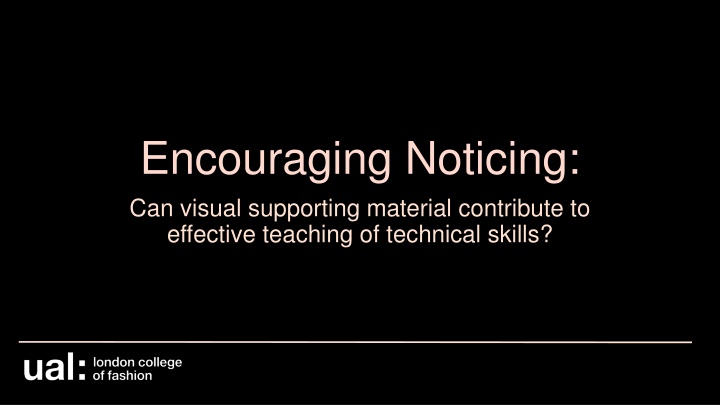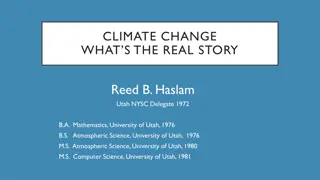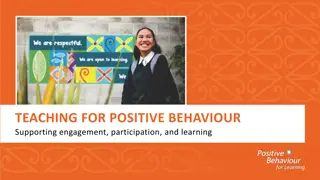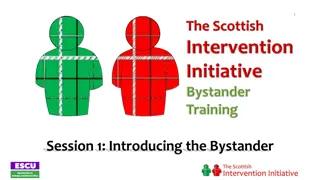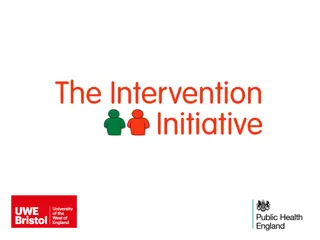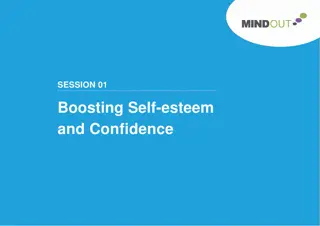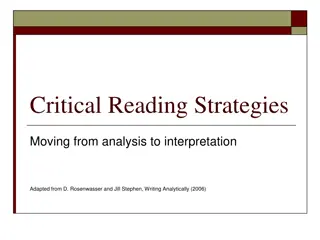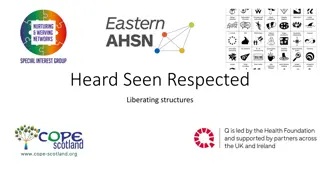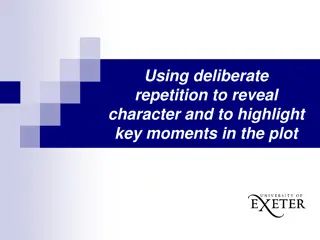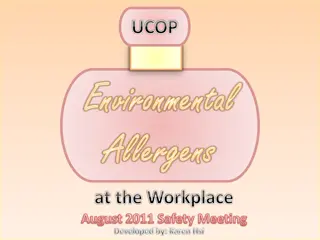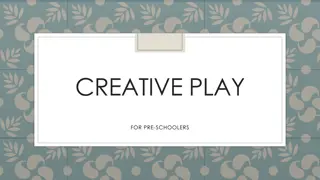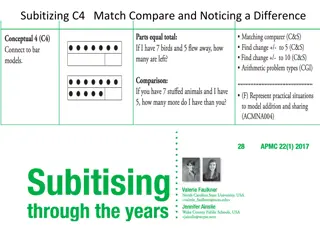Encouraging Noticing
Visual supporting materials play a significant role in the effective teaching of technical skills. This approach can enhance learning outcomes by engaging students and providing clear demonstrations. As educators continuously refine their teaching methods based on student responses, the iterative development of teaching skills may influence learning experiences. Utilizing a combination of visuals, demonstrations, and varied explanations can help improve understanding and application of complex concepts. By incorporating feedback and observations, educators can adapt their teaching strategies to better cater to student needs and enhance overall learning experiences.
Download Presentation

Please find below an Image/Link to download the presentation.
The content on the website is provided AS IS for your information and personal use only. It may not be sold, licensed, or shared on other websites without obtaining consent from the author.If you encounter any issues during the download, it is possible that the publisher has removed the file from their server.
You are allowed to download the files provided on this website for personal or commercial use, subject to the condition that they are used lawfully. All files are the property of their respective owners.
The content on the website is provided AS IS for your information and personal use only. It may not be sold, licensed, or shared on other websites without obtaining consent from the author.
E N D
Presentation Transcript
Encouraging Noticing: Can visual supporting material contribute to effective teaching of technical skills?
Q6: How much additional instruction did you need to complete a sample of the stitch? 12 Control Video PDF 10 None A lot 8 6 4 2 0 1 2 3 4 5 6 7 8 9 101112131415161718192021222324252627282930313233343536373839404142434445464748495051525354555657585960616263 Respondent
Q6 Control Video PDF Mean 5.15 5.04 4.72 Standard Deviation 2.76 2.51 2.13
Video then in person increased confidence. Speaking and visuals helped focus. Participant Response
As I repeat the demonstration, I am varying the way I explain the process, incorporating adjustments in response to my observations of areas that students are finding problematic. I am drawing attention to where to apply the tension on the thread. . . and how to vary the size of the loop to make it more manageable. Could the iterative development of my own skill as a teacher be affecting the responses? Field Observation Note- 30th October 2023
As you, the educator-researcher, interacts with participants, you may find it necessary to continue the research with additional data sources to better address the question at the center of your research. When educators are researchers and a participant in their study, it is especially important to keep an open mind to the wide range of research methodologies. Spencer Clarke et al. (2020) Action Research. Available at: https://kstatelibraries.pressbooks.pub/gradactionresearch/ (Accessed: 7 Jan 2024).
Bibliography Allery, L. (2020) How to Teach Practical Skills. Cardiff: Centre for Medical Education. Andrade, C. (2020) Mean difference, standardized mean difference (SMD) and their use in meta-analysis: as simple as it gets , Journal of Clinical Psychiatry, 81(5), article number 20f13681. Available at: https://doi.org/10.4088/JCP.20f13681 Bhagat, D. and O Neill, P. (2011) Inclusive practices, inclusive pedagogies: learning from widening participation research in art and design higher education. Croydon: CHEAD. Billett, S. (2010) Learning Through Practice: Models, Traditions, Orientations and Approaches. Dordrecht: Springer. Bogner, K., & Landrock, U. (2016) Response Biases in Standardised Surveys.GESIS Survey Guidelines. Mannheim: GESIS Leibniz Institute for the Social Sciences. Available at: https://doi: 10.15465/gesis-sg_en_016 Coffield, F. et al. (2004) Learning styles and pedagogy in post-16 learning: A systematic and critical review. London: Learning and Skills Research Centre. Curry, L. (1990) A critique of the research on learning styles , Educational Leadership. 48(2), pp.50 56. Dunn, R. (1984) Learning Style: State of the science , Theory Into Practice, 23(1), pp.10-19. Finnegan, T. and Richards, A. (2016) Retention and attainment in the disciplines: Art and Design. York: Higher Education Academy. Francis, J.J. et al. (2010) What is an adequate sample size? Operationalising data saturation for theory-based interview studies , Psychology and Health, 25(10), pp. 1229-1245. Freeman, C. and Kobia, C. (2016) Sewing for a Cause: Implementing and Evaluating Service-Learning in a Clothing Construction Course , Journal of Public Scholarship in Higher Education, 6, pp.45-59. Giacomino, K. et al. (2020) The effectiveness of the Peyton s 4-step teaching approach on skill acquisition of procedures in health professions education: A systematic review and meta analysis with integrated meta-regression, PeerJ, 8(10129), pp.1-26. Available at: http://doi.org/10.7717/peerj.10129 Gray, C. & Malins, j. (2004) Visualising Research: A guide to the research process in Art and Design. Aldershot: Ashgate Publishing Ltd. Gurung, R. & Prieto, L. (2009), Getting culture: incorporating diversity across the curriculum. New York: Routledge. Harris, A. (2021) A Sensory Education. Abingdon and New York: Routledge. Hughes, C. & Cohen, R. L. (2010) Feminists really do count: the complexity of feminist methodologies , International Journal of Social Research Methodology, 13(3), pp.189-196. Kara, H (2022) Embodied Data Analysis. Available at: https://www.youtube.com/watch?v=k79AWH59JpQ/ (Accessed: 7 January 2024) Kolb, D.A. (1984) Experiential learning: experience as the source of learning and development. New Jersey: Prentice Hall Inc.
Bibliography continued Lahti, H. (2012) Learning sewing techniques through an inquiry , Procedia Social and Behavioural Sciences, 45, pp.178-188. Madriaga, M. et al. (2010) Confronting similar challenges? Disabled and non disabled students learning and assessment experiences ,Studies in Higher Education, 35(6), pp.647-658. Mayer, A. (2021) Reducing respondents perceptions of bias in survey research , Methodological Innovations, 14(3). Available at: https://journals.sagepub.com/doi/10.1177/20597991211055952 McNiff, J. (2002) Action Research for Professional Development. Jean McNiff. Morse, J.M. et al. (2002), Verification Strategies for Establishing Reliability and Validity in Qualitative Research , International Journal of Qualitative Methods, 1(2), pp.13-22. Moussa, N. (2014) The Importance of Learning Styles in Education , Institute for Learning Styles Journal, 1(Fall), pp. 19-27. Niiranen, S. (2019) Supporting the development of students technological understanding in craft and technology education via the learning- by-doing approach , International Journal of Technology and Design Education, 31, pp.81 93. Noga, H. (2014) Applying Chosen Teaching Methods in Technical Education , International Journal of Engineering Pedagogy, 4(4), pp.23-26. Reynolds, M. (1997) Learning Styles: A Critique , Management Learning, 28(2), pp.115-133. Rohrer, D. & Pashler, H. (2012) Learning styles: Where s the evidence? , Medical Education, 46, pp.634-635. Romero, P. et al. (2018) Halsted s See One, Do One, and Teach One versus Peyton s Four-Step Approach: A randomized trial for training of Laparoscopic Suturing and Knot Tying , Journal of Surgical Education, 75(2), pp.510-515. Royal Society of Chemistry (2024) Practically Perfect. Available at: https://edu.rsc.org/ideas/how-to-help-students-develop-their-practical- skills/4016986.article. (Accessed: 11 January 2024) Shildrick, M. (2012) Critical Disability Studies: rethinking the conventions for the age of postmodernity. London: Routledge. Slocum, A. & Beard, C. (2005) Development of a CAI Module and Comparison of its Effectiveness with Traditional Classroom Instruction , Clothing and Textiles Research Journal, 23(4), pp.298-306. Spencer Clarke et al. (2020) Action Research. Available at: https://kstatelibraries.pressbooks.pub/gradactionresearch/ (Accessed: 7 January 2024). Wang, T. et al. (2004) An Education Theory Based Method to Teach a Procedural Skill , Archives of Dermatological Research, 140(11), pp.1357- 1361. Willis, S. (2017) Literature review on the use of VAK learning strategies , The STeP Journal, 4(2), pp. 90-94. Wood, N. et al. (2009) A Tacit Understanding: The Designer s Role in Capturing and Passing on the Skilled Knowledge of Master Craftsmen , International Journal of Design, 3(3), pp.65-78.
'the purpose of demonstration and these set-ups is to guide the students in the art of noticing, to help them to learn how to see.' Harris, A. (2021) A Sensory Education. Abingdon and New York: Routledge.
'Educators should instead focus on developing the most effective and coherent ways to present particular bodies of content, which often involve combining different forms of instruction, such as diagrams and words, in mutually reinforcing ways. Rohrer, D. & Pashler, H. (2012) Learning styles: Where s the evidence? , Medical Education, 46, pp.634-635.
Participants Learning Background and Learning Outcome: Identifying the level of technical knowledge prior to the intervention and learning outcome after the intervention. Q1: WERE YOU AWARE OF A CHAIN STITCH BEFORE THE DEMONSTRATION? Q2: HAVE YOU SEWN A CHAIN STITCH BEFORE? Q3: WERE YOU ABLE TO COMPLETE A CHAIN STITCH TODAY? 2% 3% 3% 3% 5% 14% No Yes N/A No Yes N/A No Yes N/A 83% 92% 95%
Q4: How clear was the demonstration? 12 10 Muddy Clear 8 6 4 2 0 1 2 3 4 5 6 7 8 9 101112131415161718192021222324252627282930313233343536373839404142434445464748495051525354555657585960616263 Respondants
Q5: How confident are you that you understand how to sew a chain stitch? 12 Not Confident Confident 10 8 6 4 2 0 1 2 3 4 5 6 7 8 9 101112131415161718192021222324252627282930313233343536373839404142434445464748495051525354555657585960616263 Respondants
